By Michael E. Haskew
Only 340 miles from the home island of Kyushu, the final objective of the American military surge across the Pacific during World War II, short of an invasion of Japan itself, was Okinawa in the Ryukyu archipelago.
On April 1, 1945, an ironically coincidental observance of Easter Sunday and April Fools Day, American troops stormed ashore at Okinawa. The island’s capture would provide a staging area for the expected invasion of Japan, the location of airfields from which U.S. planes could operate, and anchorages for American shipping to support the coming final offensive.
The fight for Okinawa was long and bitter—the bloodiest of the war in the Pacific. The island was not declared secure until the end of June, and the land battle cost the Americans more than 39,000 men killed, wounded, and missing. The Japanese suffered horrendous casualties, 110,000 dead and nearly 11,000 captured.
During the 83-day struggle for the island, American Marines and Army troops were dependent on the warships and supply vessels of the U.S. Navy clustered offshore. The naval lifeline enabled the Americans to prosecute a protracted land campaign; however, the longer the ships were anchored or on patrol in the waters off Okinawa the more they were exposed to Japanese air attack, particularly a new and horrific type of assault, a foretaste of which the Americans had experienced in the Philippines and off Iwo Jima during earlier operations—the Kamikaze.
The Kamikazes of Okinawa
Keenly aware that the Japanese would defend Okinawa fanatically by land, sea, and air, Vice Admiral Richmond Kelly Turner, commander of U.S. amphibious forces in the Pacific, devised a system of early warning against massed Japanese air attacks. Turner ordered the establishment of 16 radar picket stations around Okinawa and along the most likely avenues of approach any attackers would utilize. Turner hoped that the pickets could provide precious additional time to vector fighter aircraft against approaching Japanese planes and allow surface ships to ready their antiaircraft batteries for an effective defense.
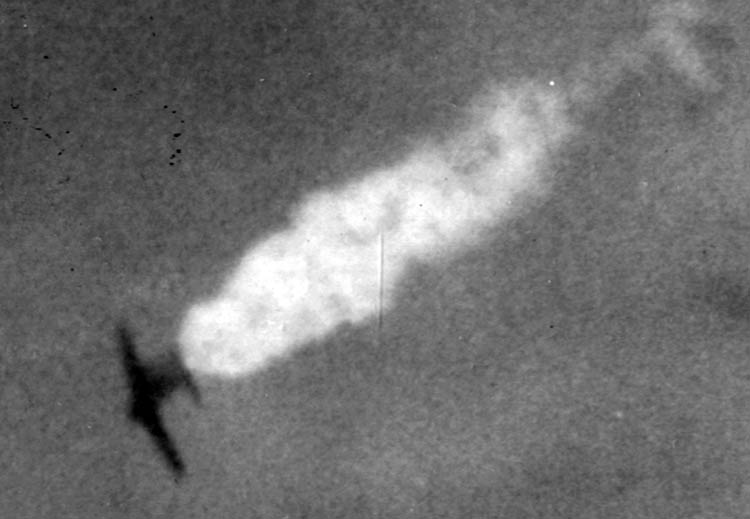
While the composition of the radar picket stations varied from time to time, they regularly included at least one or two U.S. Navy destroyers, one of which carried fighter direction equipment and personnel whose job was to keep constant watch on radar screens, possibly a destroyer escort, and several smaller support craft. Those destroyers equipped with fighter direction capabilities controlled the combat air patrol (CAP) that was aloft, while the picket ships took Japanese aircraft under fire with the mission of preventing the enemy planes from reaching vulnerable supply vessels off Okinawa or high-value targets such as the aircraft carriers and battleships that were also present.
For the Japanese, the defense of Okinawa required the maximum effort. It was do or die, and a glorious death in battle brought great honor to an individual. Young Japanese men were imbued with the ancient code of Bushido, “the way of the warrior,” that dictated honor, loyalty, obedience to superiors, and a willingness to die for the emperor. Closely associated with the samurai warrior class, Bushido exhorted Japanese soldiers, sailors, and airmen to sacrifice themselves in battle if necessary and to never surrender.
As the Americans drew inexorably closer to Japan, hundreds of young men were recruited as suicide pilots who would crash their bomb-laden aircraft into American ships, inflicting as much damage as possible. Named in reference to the great typhoons that destroyed the Mongol fleets of Kublai Khan bent on invading Japan in 1274 and again in 1281, these pilots were known as Kamikaze, or Divine Wind. Many of them were given only rudimentary flight training, and every available aircraft, some of them long obsolete, was recruited for the defense of Okinawa.
Operation Ten Go
By the spring of 1945, the Japanese Fifth Air Fleet, commanded by Vice Admiral Matome Ugaki, prepared to defend Okinawa to the last. The plan was simple. Massed Kamikaze attacks would strike the American fleet off the island and inflict such heavy losses on the invaders that they could not sustain the ground campaign and would be compelled to withdraw. The plan called for as many as 4,500 aircraft to be used in the operation, and the codenames of the general effort and its components belied the terrible nature of the business at hand.
Ten Go, or Heavenly Operation, was to include 10 massed Kamikaze sorties, known as Kikusui, or Floating Chrysanthemums, and each Kikusui might consist of more than 350 planes. These included bombers and fighters, old fixed-gear types, and even a few biplanes.
Also among the aerial suicide weapons hurled at the Americans was a terrifying flying bomb called the Ohka, or Cherry Blossom, packed with more than 2,600 pounds of explosives. An ancestor of the modern cruise missile, the Ohka was slung beneath the fuselage of a bomber, carried within range of the American fleet, and released. The pilot then engaged three solid fuel rockets and streaked toward the target at up to 650 miles per hour, intent on striking the enemy. American sailors and pilots referred to the Ohka as “Baka,” Japanese for idiot or fool.
Last Words of the Kamikaze
Kamikaze pilots were revered, often partaking in rituals and ceremonies prior to their final missions, toasting one another with saké and donning the traditional hachimaki headband before climbing aboard their aircraft for a rendezvous with destiny. Many wrote last letters to family or friends and left behind locks of hair, fingernails, or even a severed little finger for enshrinement.
“Keep in good health. I believe in the victory of greater Asia. I pray for the happiness of you all, and I beg your forgiveness for my lack of piety,” Kamikaze pilot Akio Otsuka wrote to friends. “I leave for the attack with a smile on my face. The moon will be full tonight. As I fly over the open sea off Okinawa, I will choose the enemy ship that is to be my target. I will show you that I know how to die bravely. With all my respectful affection….”
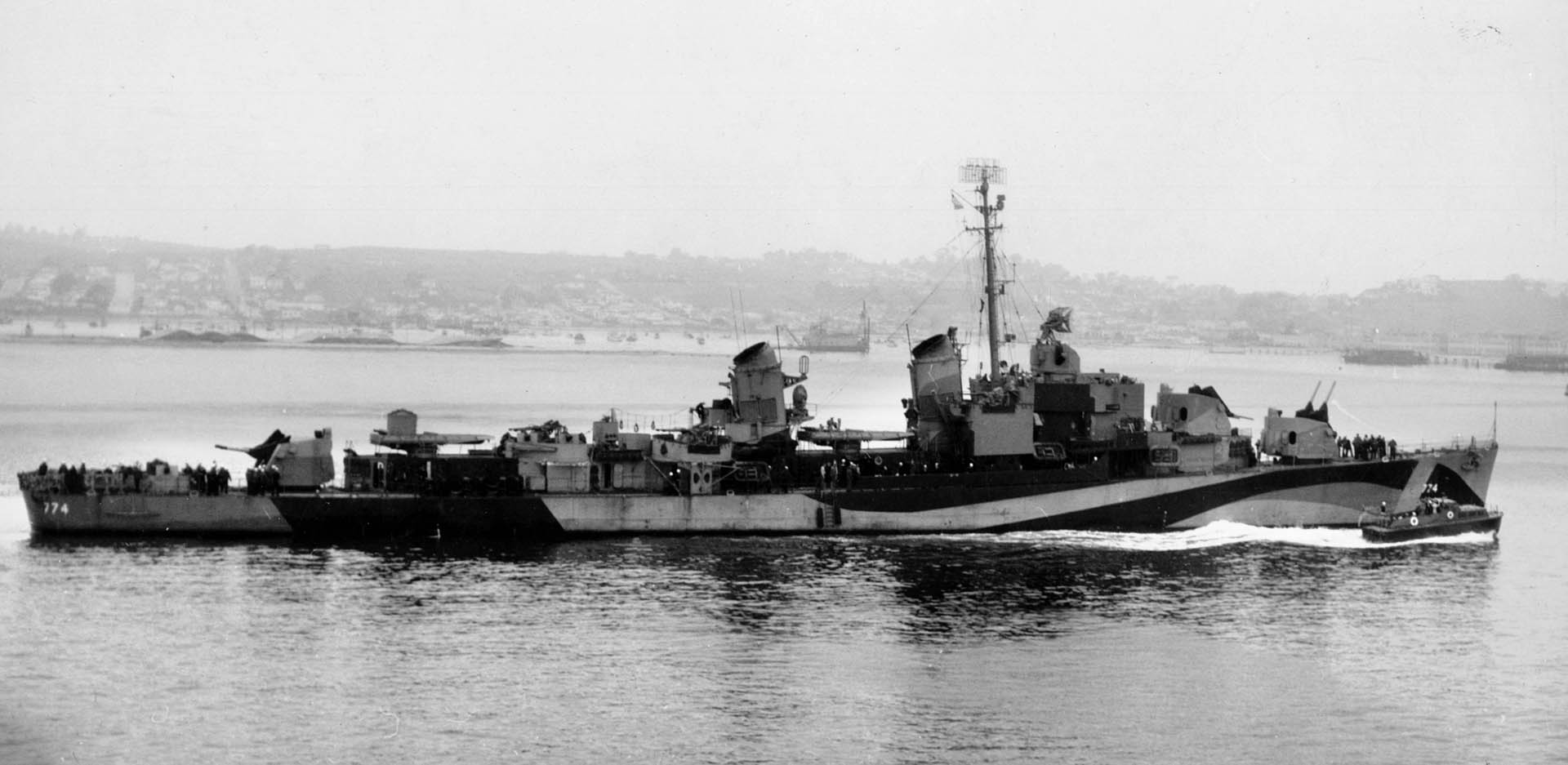
The High Cost of the Kamikaze Attacks
Ugaki marshaled both Army and Navy aircraft, most of them gathered at airfields in southern Kyushu. When the Americans landed at Okinawa on April 1, he was unable to immediately respond en masse. Although a few sorties were undertaken, American bombing and shortages of fuel and other supplies delayed Kikusui No. 1 until April 6. From that date, the fury of the Kamikaze was relentlessly visited upon the Americans, who struggled to comprehend the reality that men hoping to stay alive were defending themselves against an enemy whose intent was just the opposite—to die and cause as much damage as possible.
During the course of the Okinawa campaign, nearly 1,500 Japanese suicide pilots died attacking American ships. Twenty-nine U.S. Navy vessels were sunk and 120 damaged, while 3,048 men were killed and 6,035 wounded. The constant strain on the American sailors took its toll, psychologically and physically. After enduring a particularly vicious Kamikaze attack, one sailor simply stood up at his gun mount, declared, “It’s hot today!” and jumped over the side of his ship, never to be seen again.
The Hadley Enters the Pacific Theater
Although some major warships were struck by Kamikazes off Okinawa, including several carriers and battleships, overeager suicide pilots often attempted to crash into the first American warship they sighted, and the destroyers and other patrol craft of the picket line absorbed the devastating brunt of Operation Ten Go. The heroism of the sailors aboard these small warships was spectacular. They fought desperately and held the line, writing one of the most stirring chapters in the history of naval warfare in the process.
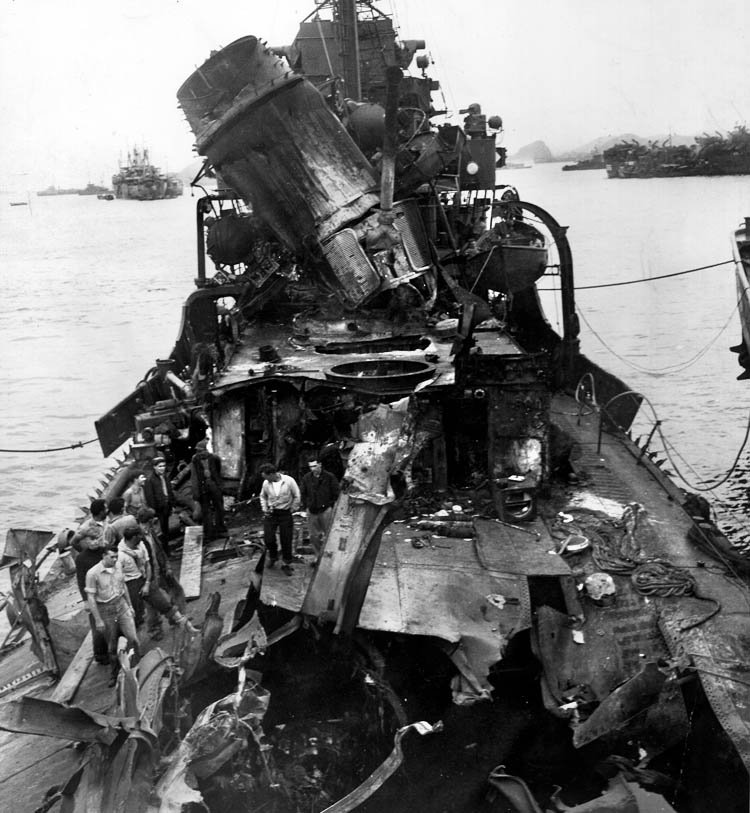
While the stories of courage on the picket line are numerous, the ordeal of the Sumner-class destroyer USS Hugh W. Hadley is exceptional and highly indicative of the savage fight that took place off the shores of Okinawa. The Hadley’s brief and violent career reached its zenith on the morning of May 11, 1945, at Radar Picket Station 15, in the East China Sea, 60 miles north of Point Bolo, on the east coast of Okinawa.
Named for a U.S. Navy officer killed in action in the Solomons in August 1942, the 2,200-ton Hadley was built in the Bethlehem Steel Company shipyards at Terminal Island, California. Her keel was laid in February 1944, she was launched five months later, and she was commissioned in November 1944 under Commander L.C. Chamberlain. The Hadley was 376 feet, six inches long with a beam of 40 feet, 10 inches, and was powered by four boilers providing 60,000 horsepower to drive turbines turning twin propeller shafts.
Armed to the proverbial teeth, the Hadley’s weaponry included six 5-inch guns double mounted in three turrets, 12 40mm Bofors and 11 20mm Oerlikon antiaircraft guns, 10 21-inch torpedo tubes, six depth-charge projectors, and a pair of depth-charge tracks. The ship’s complement numbered 336 officers and sailors.
On January 13, 1945, Commander Baron J. Mullaney took charge aboard the Hadley, and at the end of February the brand new destroyer sailed to Pearl Harbor. On March 7, the Hadley departed for Ulithi along with the escort carrier USS Santee. On the 25th, the destroyer got underway for Okinawa along with a host of transports, most of them LSTs (Landing Ship, Tank) carrying men and equipment for the upcoming invasion.
By the evening of March 31, the small islands surrounding Okinawa came into view. The Hadley’s guns fired in anger for the first time, shooting down a Japanese Mitsubishi G4M Betty bomber, one of several aircraft that had been shadowing and harassing the American ships. The following morning, the Okinawa landings took place, and the Hadley was then assigned to antisubmarine duty. An escort mission to Saipan was completed by mid-April, and the destroyer was back on antisubmarine patrol off Okinawa by the 27th.
Manning the Pickets
The following day, the Hadley was ordered to radar picket duty along with the destroyer R.H. Smith. A Marine Vought F4U Corsair fighter plane was forced to ditch when its engine failed, and Hadley crewmen plucked the pilot from the Pacific. Tense hours were spent at general quarters due to the continuing threat of Kamikaze raids. Word reached the crew that the destroyer Aaron Ward, the warship that had preceded the Hadley in construction at the Terminal Island shipyards, had been crippled and was nearly sunk by six Kamikaze hits while on picket duty south of the Hadley’s position.
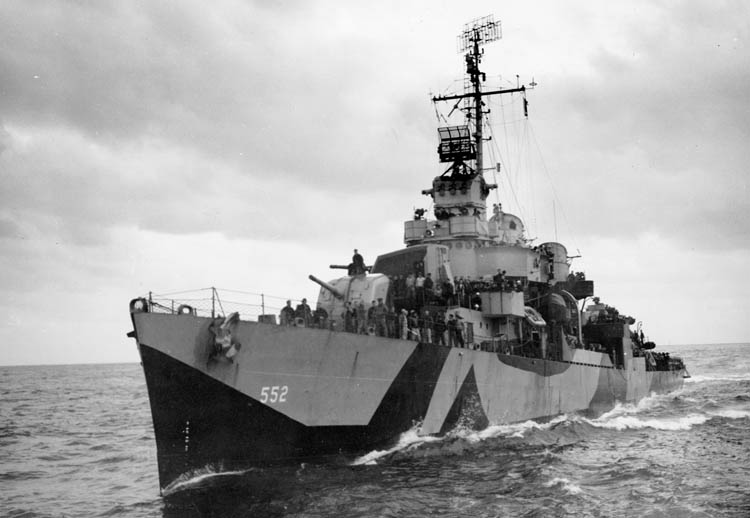
As the sun climbed into the sky on May 4, smoke billowed from the destroyer Shea, struck by an Ohka just 1,000 yards off Hadley’s port quarter. Without fighter direction equipment, the Hadley took control of the nearby combat air patrol as best it could until relieved a couple of hours later. Following a brief stop at the anchorage of Kerama Retto, southwest of Okinawa, the Hadley patrolled off Hagushi Bay, a primary supply point near the mouth of the Bishi River on Okinawa and the intersection of the zones of the 1st and 6th Marine Divisions to the north and the U.S. Army’s 7th and 96th Divisions to the south.
On May 7, the Hadley came alongside the destroyer Brown, another of the few picket destroyers that had come through the gauntlet of Kamikaze attacks unscathed to date. Fighter direction equipment was transferred to the Hadley, and by the afternoon of May 10 the destroyer was in position on Radar Picket Station 15. Along with the Hadley were the Fletcher-class destroyer USS Evans, under Commander R.J. Archer, LCS 82 (Landing Craft, Support), LCS(L) 83 and LCS(L) 84 (Landing Craft Support, Large), and LSM(R) 193 (Landing Ship, Medium, Rocket). With grim humor, American sailors had begun referring to the smaller ships that accompanied the destroyers on the picket line as “pallbearers.”
“Commence Firing, Starboard Side!”
An uneasy calm settled around Radar Picket Station 15 on the morning of May 11, 1945, but everyone in the small clutch of ships knew that the Kamikaze storm would inevitably break. At 6:36 am, the combat air patrol of 12 Corsair fighters accounted for a single Japanese plane, and then at 7:45, the Hadley’s first direct contact of the day, a Japanese floatplane, was sighted.
“As I started to eat breakfast, the familiar GONG, GONG, GONG of the GQ bell sounded—again with the expected announcement, ‘General Quarters, General Quarters.’ But this announcement was different, however, as it was followed, breathlessly, by the words, ‘Commence Firing, Commence Firing, starboard side!’” remembered Doug Aitken, a young officer aboard the Hadley who years later retired from the Navy with the rank of captain.
“The intruder which called us to General Quarters was a single aircraft, a Japanese floatplane flying very low on the water directly at us,” Aitken continued. “It had escaped detection by both air and surface search radars, and also the Combat Air Patrol (CAP) of high flying Marine F4U Corsairs which we directed from our ship. Fortunately, we were alert, and our gunners shot it down close aboard. Everyone became intensely alert as we remained at GQ wondering what was next. All was quiet again for a few minutes. Then they came.”
Commander Mullaney later reported that the aircraft was “taken under fire by both ships (Hadley and Evans). Soon, this plane headed away from the Evans and came directly for the Hadley which was about one and a half miles from the Evans. This plane was shot down by the Hadley at the range of 1,200 yards.”
150 Enemy Aircraft
The single Japanese aircraft was a harbinger of the hell to come, the herald of more than 150 enemy planes, including Kamikazes, their fighter escort, conventional bombers, and the dreaded Ohkas that comprised Kikusui No. 6. For the next two hours, the seamen at Radar Picket Station 15 fought for their lives against overwhelming odds. The dozen Corsairs of the combat air patrol gamely engaged the swarms of Japanese planes, and with additional fighters that subsequently arrived, accounted for about 40 of the enemy. However, it was simply impossible to shoot them all down.
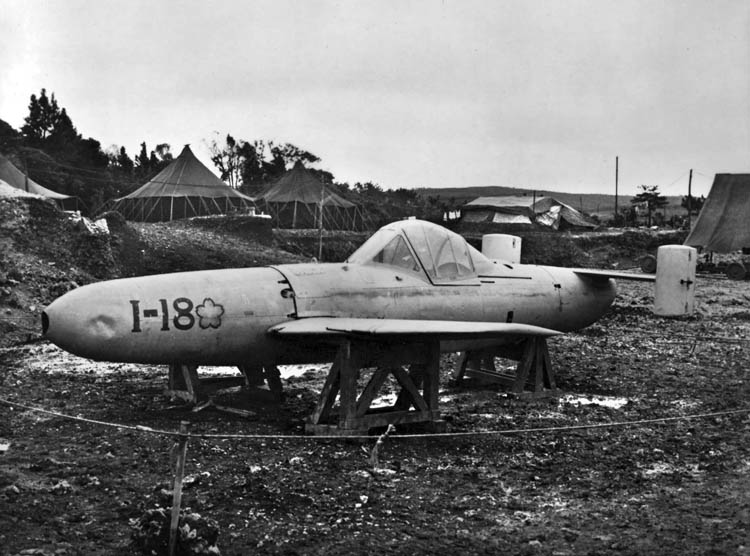
Within minutes of the first encounter, Mullaney and his officers on the bridge of the Hadley were shocked at what they saw. “At about 0755 numerous enemy planes were contacted by our instruments as coming towards the ship (and Okinawa) from the north, distance about 55 miles,” he wrote in his after action report. “One division of CAP was ordered out to intercept. Shortly thereafter, several enemy formations were detected, and the entire CAP was ordered out to intercept. Our Fighter Director Officer in CIC (combat information center) had estimated the total number of enemy planes as 156 coming in at different heights in groups as follows: Raid ONE 36, Raid TWO 50, Raid THREE 20, Raid FOUR 20 to 30, Raid FIVE 20, Total 156 planes.
“Shortly we received reports from them [CAP] that they had destroyed twelve planes,” Mullaney continued. “Then they were so busy that they could not send us reports but we intercepted their communications to learn about 40 to 50 planes were destroyed by them. CIC reported that there were no friendly planes within ten miles of this ship.”
Kamikaze Attempts Against the Hadley
Japanese suicide attacks against the Hadley and the Evans were unceasing. Attacking singly or in groups of four or more, the Kamikazes pressed their suicide runs, and the tiny ships worked in mutual support as best they could. The destroyers became separated by as much as two to three miles as they maneuvered, but they strained to concentrate their fire.
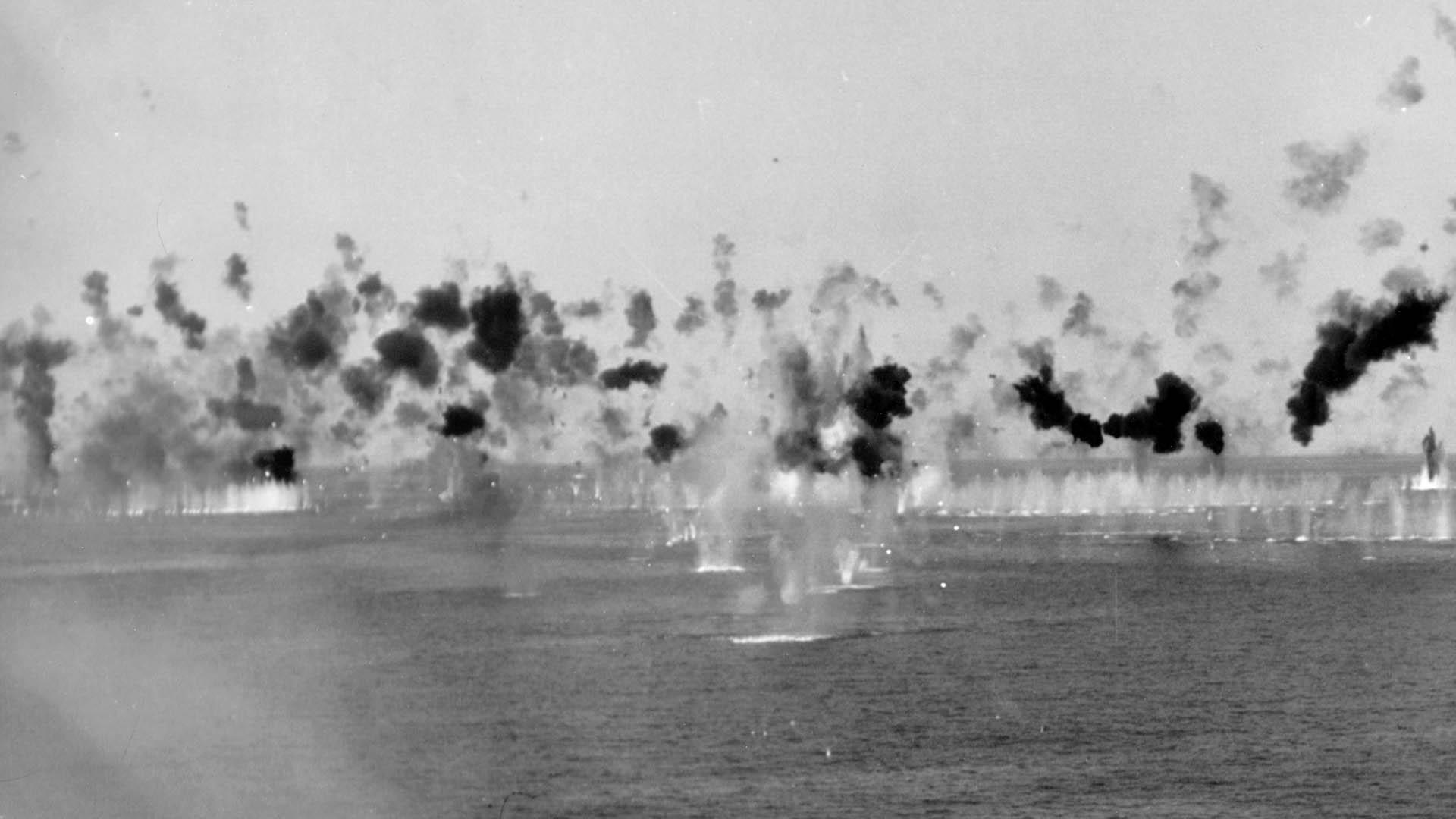
The Hadley heeled to bring as many guns as possible to bear on a Japanese Aichi D3A Val dive bomber, screaming downward. The attacker’s speed and violent maneuvering made it virtually impossible for the destroyer’s gunners to assess the range to their rapidly closing target. At about 5,000 yards the 5-inch guns barked, then the staccato of the 40mm mounts joined in, and at 2,000 yards the chatter of the 20mm cannon could be heard. A thin ribbon of smoke began to trail from the stricken Kamikaze, but still it came on. Seconds later, dark smoke and flame erupted and a wing was torn from the Val. The shredded plane nosed up and plunged into the sea a mere 100 yards away.
Swarms of Japanese planes seemed to fill the sky, and the Corsair pilots of the combat air patrol shot them down until their .50-caliber machine guns had no more ammunition. Still, the Marine pilots pursued the enemy planes, feigning attacks and even causing some Japanese aircraft into such violent maneuvering that their inexperienced pilots lost control and plunged into the Pacific.
“Obviously, the Marines could not stop them all,” wrote Lieutenant (j.g.) Thomas Dwyer of the Hadley, “and many broke through, circling the two destroyers like the Indians around the wagon train. From time to time, the Japanese would launch crudely coordinated attacks … against the embattled ships.”
The Evans is Taken Out of the Fight
During the opening minutes of the fight, the Hadley’s gunners flamed four Japanese planes that were attempting to slip through Radar Picket Station 15 and move on toward the invasion fleet closer to Okinawa’s shoreline. Kamikazes attacked the Hadley in steep dives of 45 degrees or more, and during the frantic half hour between 8:30 and 9 am, the Hadley’s gunners accounted for a dozen enemy aircraft. The Evans was assailed from virtually all points of the compass, blazing away and downing a total of 15 planes in the running duel and assisting in destroying another four.
Both little warships steered in circles, their rudders hard over to bring every available gun to bear, and churned the water at 27 knots. At 8:35 am, the Hadley’s rudder went hard over to avoid a Kamikaze dive bomber that was careening downward and only 1,000 feet above the ship. The destroyer swung away from the pilot’s aiming point, and he splashed a scant 20 feet from the Hadley’s stern. At 9 am, the two ships were three miles apart, too distant to lend mutual aid and firepower. In a flash, disaster struck the Evans.
Lieutenant James M. Smith, ship’s doctor aboard the Evans, remembered a “whirlwind of planes coming at us from every direction. Guns were firing so rapidly that reliefs had to be afforded to exhausted loaders. The ship was surrounded with smoke from our own fire, and it was difficult to spot the Japs because of the black shell bursts that mingled with them.’
“After one hour, 13 minutes of splashing all attacking planes,” Smith continued, “a Kamikaze artist maneuvered through the barrage and winged over on the port bow. A hole at the waterline resulting from this hit flooded one living compartment. In quick succession, hits two, three, and four occurred. The second and third resulted in critical damage to the Evans. An Oscar [Japanese Army Nakajima Ki-43 fighter] struck at the waterline on the port side. The flaming plane hurtled onto the fantail. Its bomb exploded under the after engineering spaces, flooding them immediately.”
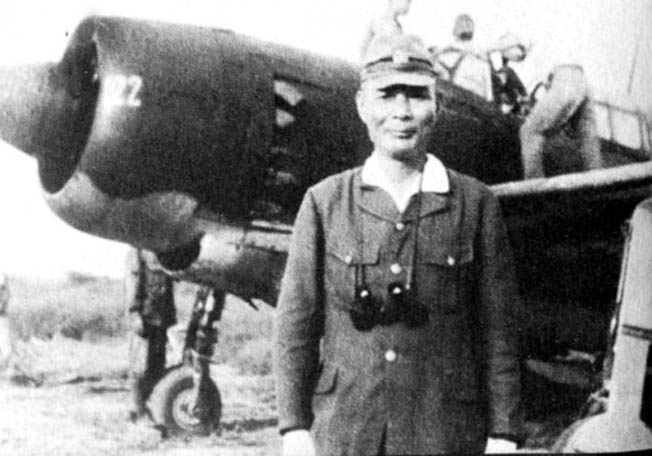
The Evans lost all power and went dead in the water. Her executive officer was blown over the ship’s side, and an alert seaman jumped in to rescue him. Outstanding work by damage control parties kept the Evans from sinking, but the ship was out of the fight. In the afternoon, the stricken destroyer was taken in tow by the fleet tug USS Cree and reached temporary drydock at Kerama Retto. After makeshift repairs, the Evans was towed to Saipan, Pearl Harbor, and then Mare Island Navy Yard in San Francisco. Thirty-two members of the Evans’ crew were killed in action on May 11, and 27 wounded—but the indomitable ship survived.
Fighting Singlehandedly
The Hadley fought on. Her tiny consorts did their best in support. Gunners aboard LSM(R) 193 fired their single 5-inch gun as rapidly as possible. With each discharge, the recoil shook the small vessel like a rag doll. Corsairs swooped and jigged, braving the friendly fire from below to ward off the Kamikazes. The Hadley put up a wall of steel.
Shortly after the Evans was hit, an overwhelming attack finally penetrated the defenses and literally mauled the gallant Hadley. Lookouts spotted 10 Kamikazes closing on the destroyer.
Commander Mullaney reported later, “For 20 minutes, the Hadley fought off the enemy singlehanded being separated from the Evans, which was out of action, by three miles and the four small support ships by two miles. Finally, at 0920, ten which had surrounded the Hadley, four on the starboard bow under fire by the main battery and machine guns, four on the port bow under fire by the forward machine guns, and two astern under fire by the aft machine guns, attacked the ship simultaneously. All ten planes were destroyed in a remarkable fight and each plane was definitely accounted for…”
Three Kamikaze Hits on the Hadley
The Hadley, however, was grievously wounded. Eyewitness accounts vary; however, it is generally accepted that in approximately four minutes of furious action the destroyer was hit by three Kamikazes and a single 550-pound bomb.
Dwyer remembered, “Hadley took her first Kamikaze hit on the after port quad 40mm mount (Mount 44). Mount Captain Nicholas’s last words were, ‘We’ll get the S.O.B.’ as the aircraft dove right down the barrels of the gun mount, killing the gun crew on the spot. Almost simultaneously several bombs penetrated the ship and detonated under the keel, lifting the ship out of the water. Shortly thereafter, another aircraft struck the starboard side amidships at the waterline. The fuselage pierced the hull and caused heavy loss of life and severe flooding in the engine and fire rooms. Yet another Kamikaze dove on the ship and passed between the foremast and the after stack, clipping some wires as it fell harmlessly into the sea.”
Aitken remembered, “USS Hadley suffered three hits: one was not serious; the second and third proved fatal. The second, at the waterline, opened up virtually all engineering spaces to the sea. A 550 lb. bomb carried by that Kamikaze exploded directly under the ship humping the bottom nearly five feet as would a depth charge explosion. Moments later, the third Kamikaze crashed the after deck house quad 40mm gun area with disastrous results.”
A third account asserts that the initial Kamikaze to strike the Hadley was an Ohka, released by a Japanese bomber at 9:05 am, followed by a crash on the aft deck that destroyed several guns, and the last Kamikaze hit at the waterline.
Commander Mullaney’s report stated bluntly, “As a result of this attack, the Hadley was: (1) Hit by a bomb aft (2) By a BAKA seen to be released from a low flying BETTY (3) Was struck by a suicide plane aft (4) Hit by a suicide plane in rigging.”
The damage was devastating. The destroyer billowed smoke and flame. Scores of sailors were dead or wounded. Yet another Kamikaze came screaming down at the Hadley, but the few guns still operational sent it crashing into the ocean. Then, there were no more. The Kikusui had dissipated as rapidly as it appeared.
Keeping the Hadley Above Water
Now, Commander Mullaney and his crew were desperately trying to keep their stricken ship afloat. The Hadley listed to starboard, her fantail was awash, and the ship went dead in the water. It appeared that she could capsize at any moment. Explosive Torpex dripped from the warheads of rapidly heating torpedoes that threatened to cook off and blow the ship to pieces.
Mullaney ordered nearby crewmen to hoist all U.S. flags and any other colors available up the halyards, shouting, “If this ship is going down, she’s going with all flags flying.”
The captain later reported, “The ship was badly holed and immediately both engine rooms and one fireroom were flooded and the ship settled down and listed rapidly. All five-inch guns were out of action, a fire was raging aft of number two stack, ammunition was exploding, and the entire ship was engulfed in a thick black smoke which forced the crew to seek safety, some by jumping over the side, others by crowding forward and awaiting orders. The ship was helpless to defend herself and at this time the situation appeared hopeless. The Commanding Officer received reports from the Chief Engineer and the Damage Control Officer which indicated that the main spaces were flooded….”
“The engineers were securing the forward boilers to prevent them from blowing up,” Mullaney continued. “The order to ‘prepare to abandon Ship’ was given and life rafts and floats were put over the side. A party of about fifty men and officers were being organized to make a last fight to save the ship and the remainder of the crew and the wounded were put over into the water.”
As those in the water were picked up by other vessels, the drama of the 50 bold men aboard the Hadley unfolded. Torpedoes and unexploded ammunition were rolled and thrown over the side. Hoses were played on the flames for 15 minutes. Weight was shifted from starboard to port to help counteract the list. The fire was brought under control, and the flooding stopped. A single fireroom bulkhead held.
The fast transport USS Barber, auxiliary fleet tug ATR-114, and destroyer USS Wadsworth came up to render assistance, the Wadsworth’s lookouts searching the sky for any renewed Japanese threat. While LCS 82 and LCS(L) 84 had their hands full with the heavily damaged Evans, LSM(R) 193 and LCS(L) 83 began towing the Hadley about noon to the nearest relative safety, the temporary anchorage at Ie Shima, a small island northwest of Okinawa.
23 Aircraft Shot Down
Credited with shooting down 23 Japanese planes during the May 11 fight on the picket line, the USS Hadley established a U.S. Navy record for enemy aircraft destroyed in a single engagement. Her guns fired 801 rounds of 5-inch ammunition, 8,950 rounds of 40mm, 5,990 rounds of 20mm, and 801 charges of smokeless gunpowder. Miraculously, the Hadley had survived her epic struggle. Twenty-eight of her crew were killed in action. Two more died of their injuries later, and 68 were wounded.
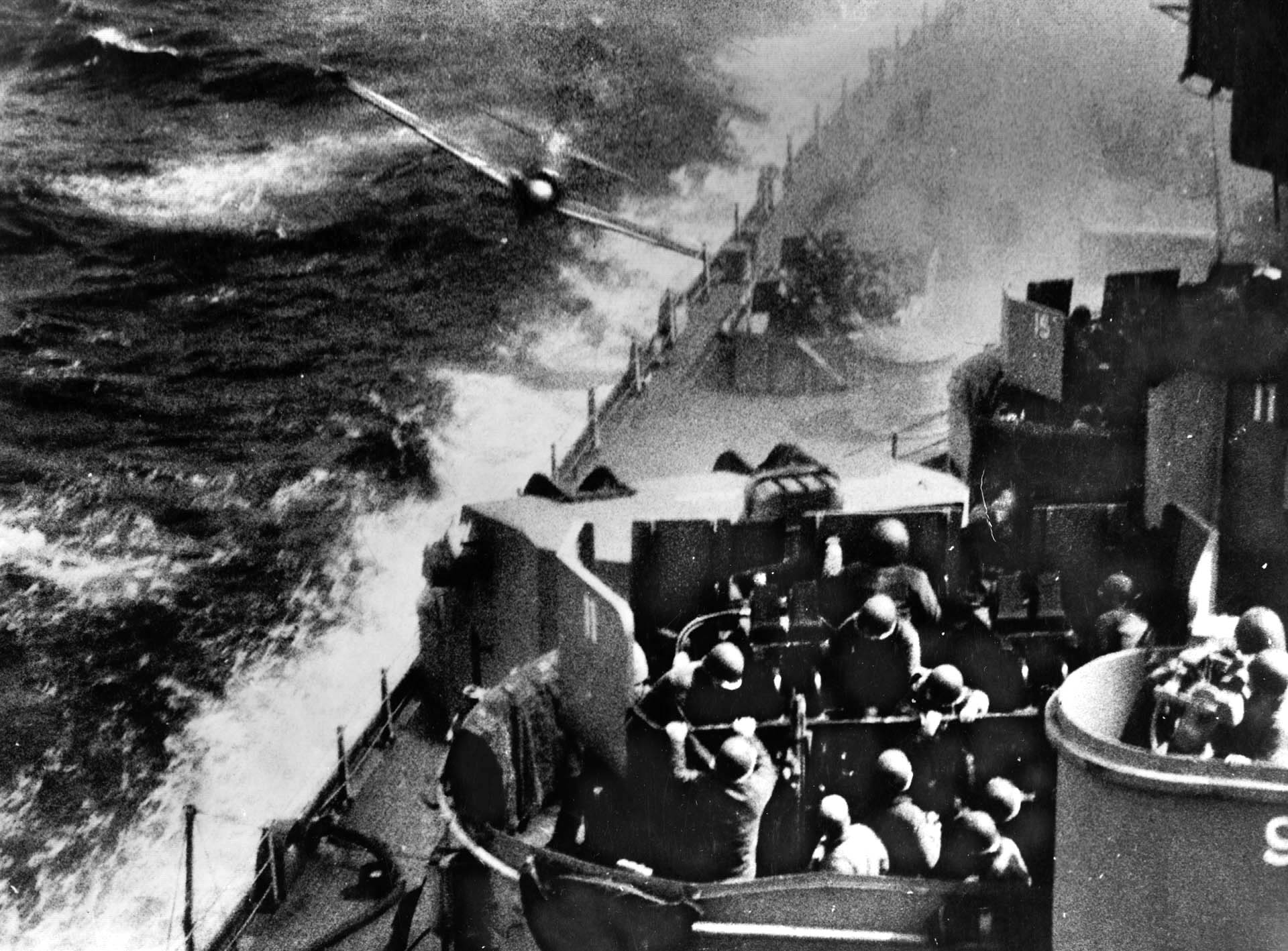
Later, the battle-blackened destroyer was towed to Kerama Retto and entered floating drydock ARD 28 for temporary repairs. Sailors from the repair ship USS Zaniah went to work. In July, steel I-beams were welded to the interior of the hull to hold the shattered destroyer together, and the exterior of the hull was patched with steel plating. From there, the Hadley was towed to Buckner Bay, the main Okinawa anchorage, provisioned, and taken in tow by the tug ATA-199.
With a reduced crew, the ship was towed 7,000 miles at an average speed of seven knots, stopping at Saipan, Eniwetok, and Pearl Harbor before the two-month odyssey ended on September 26, 1945, at Hunter’s Point Naval Shipyard near San Francisco. Along the way, the Hadley skirted a typhoon and the towline parted nine times.
A Presidential Citation For the Hadley
The gallant Hadley never went to sea again. On November 7, 1945, she was decommissioned, and on the 28th she was stricken from the U.S. Navy roll. Her entire service career had lasted less than two years. On February 11, 1947, the rusting hulk was sold for scrap. Somehow, it seems that such a heroic ship deserved a more fitting fate.
Mullaney and Lieutenant Patrick H. McGann, the Hadley’s gunnery officer, received the Navy Cross for the picket line battle, while seven members of the crew received the Silver Star, and seven the Bronze Star. More than 100 Purple Hearts were presented. The entire crew received a Presidential Unit Citation.
Perhaps, though, in summing up the superhuman effort of his crew, Commander Mullaney paid greater tribute to the ship and her complement than any medal or other acknowledgment could.
“No Captain of a man of war ever had a crew who fought more valiantly against such overwhelming odds,” Mullaney wrote. “Who can measure the degree of courage of men, who stand up to their guns in the face of diving planes that destroy them? Who can measure the loyalty of a crew who risked death to save the ship from sinking when all seemed lost? I desire to record that the history of our Navy was enhanced on 11 May 1945. I am proud to record that I know no record of a Destroyer’s crew fighting for one hour and thirty-five minutes against overwhelming enemy aircraft attacks and destroying twenty-three planes. My crew accomplished their mission and displayed outstanding fighting abilities. I am recommending awards for the few men who displayed outstanding bravery above the deeds of their shipmates in separate correspondence. Destroyer men are good men, and my officers and crew were good destroyer men.”
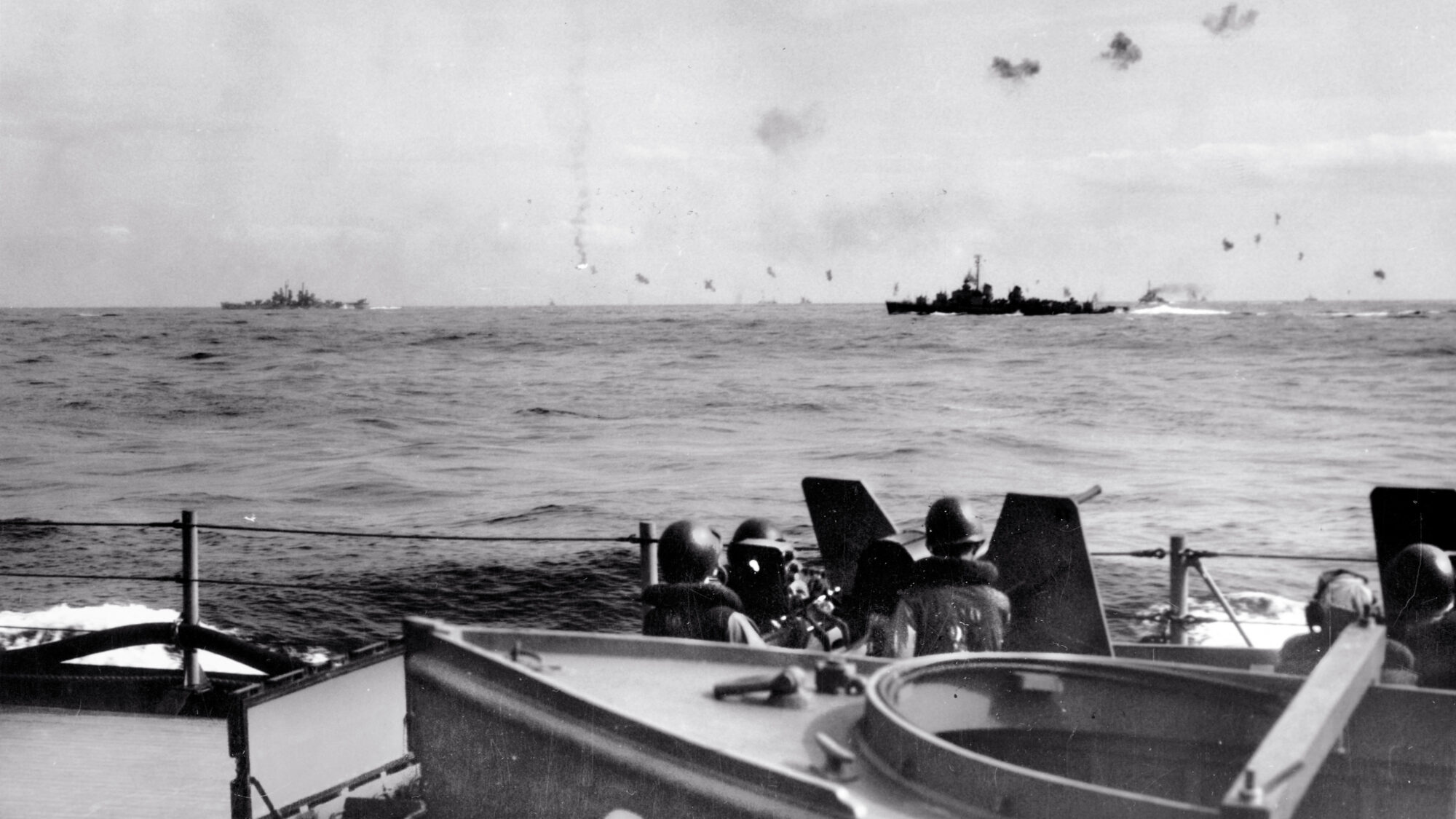

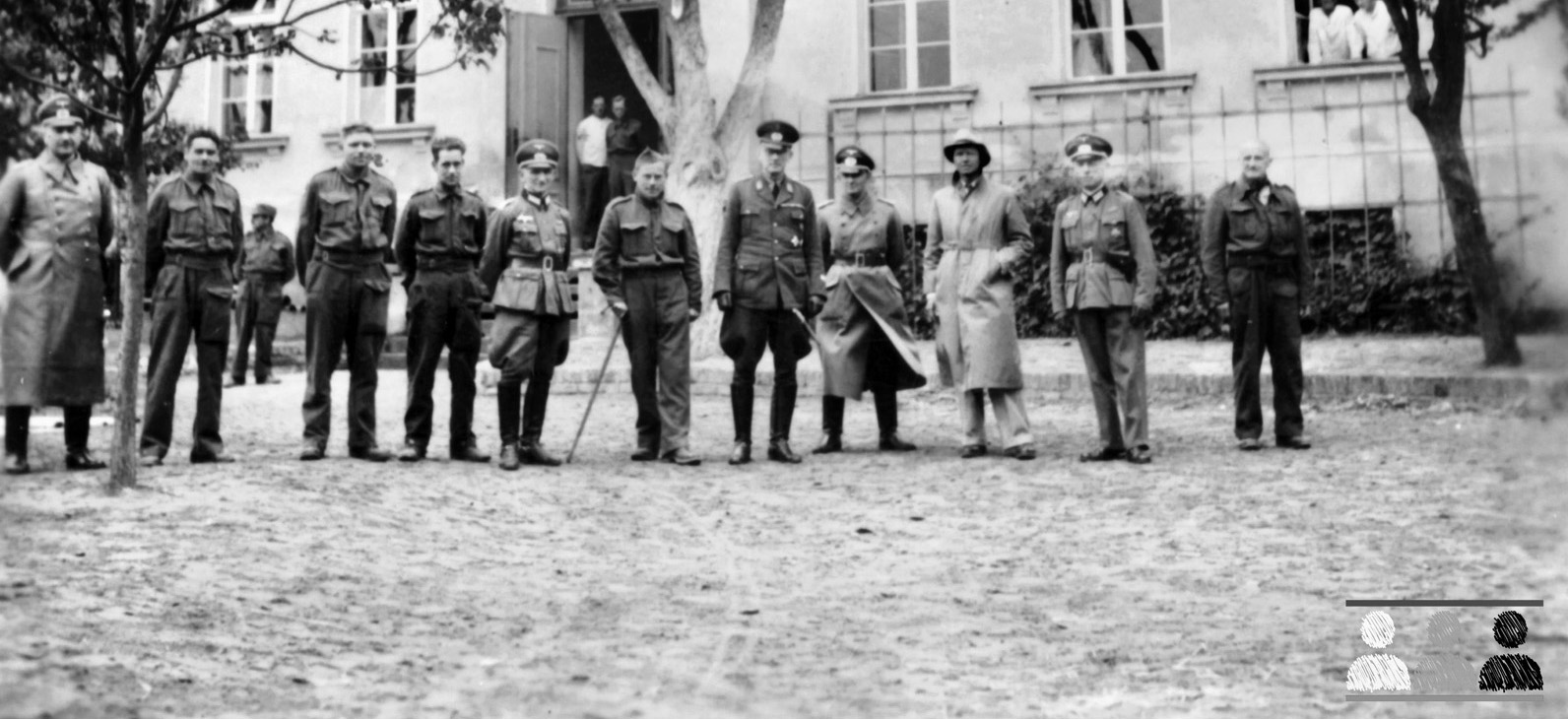
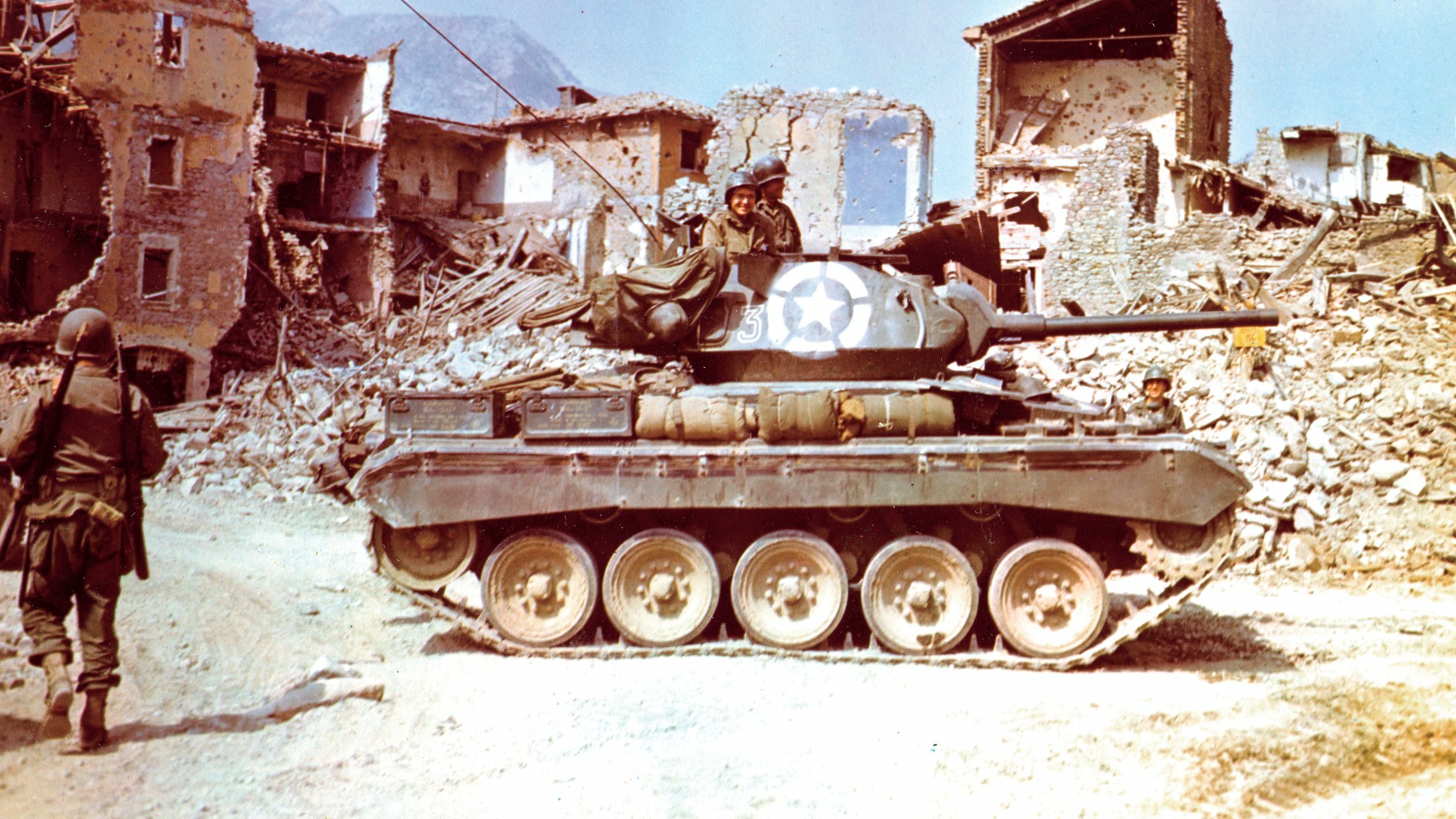
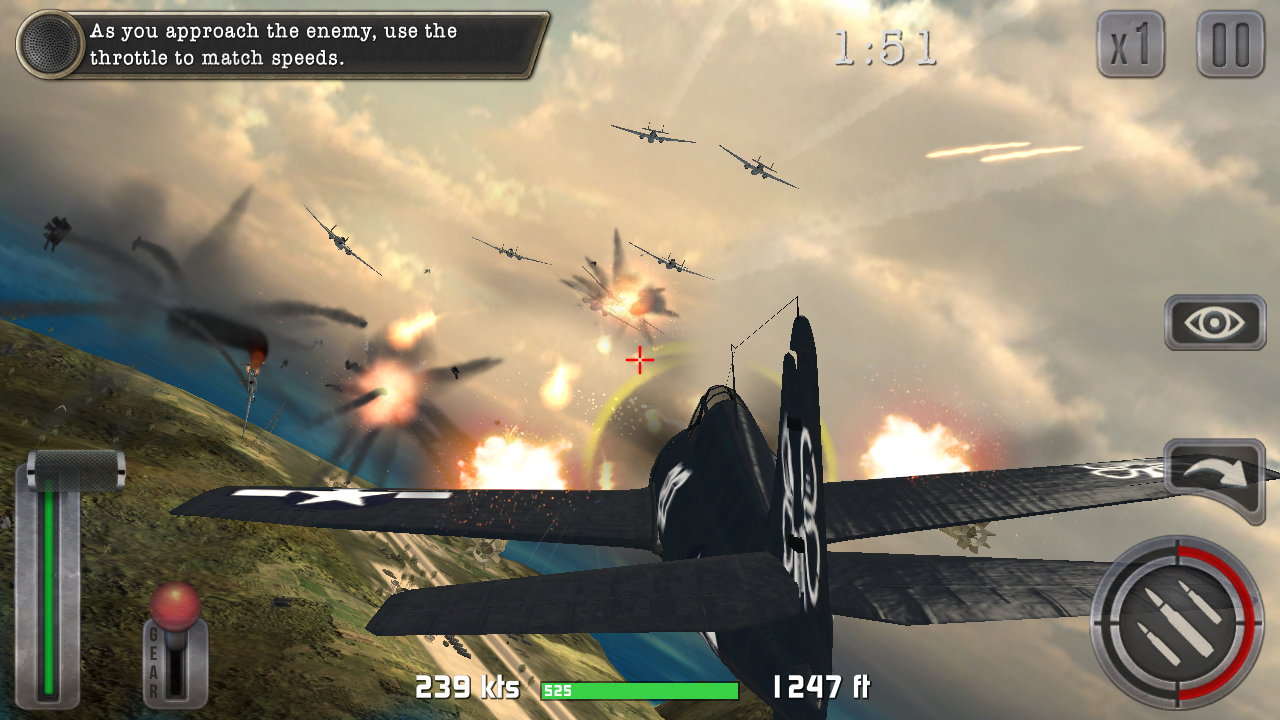
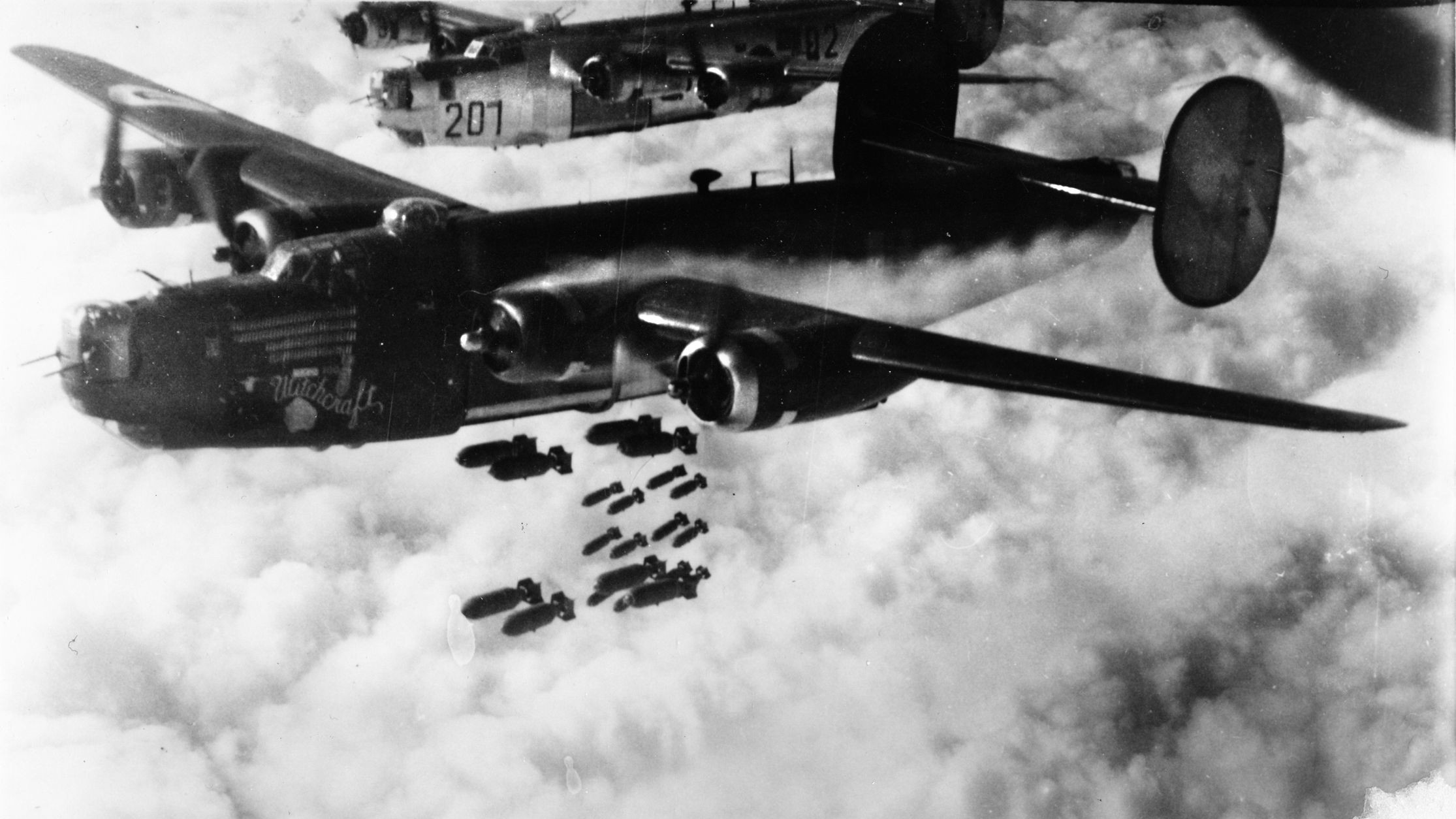
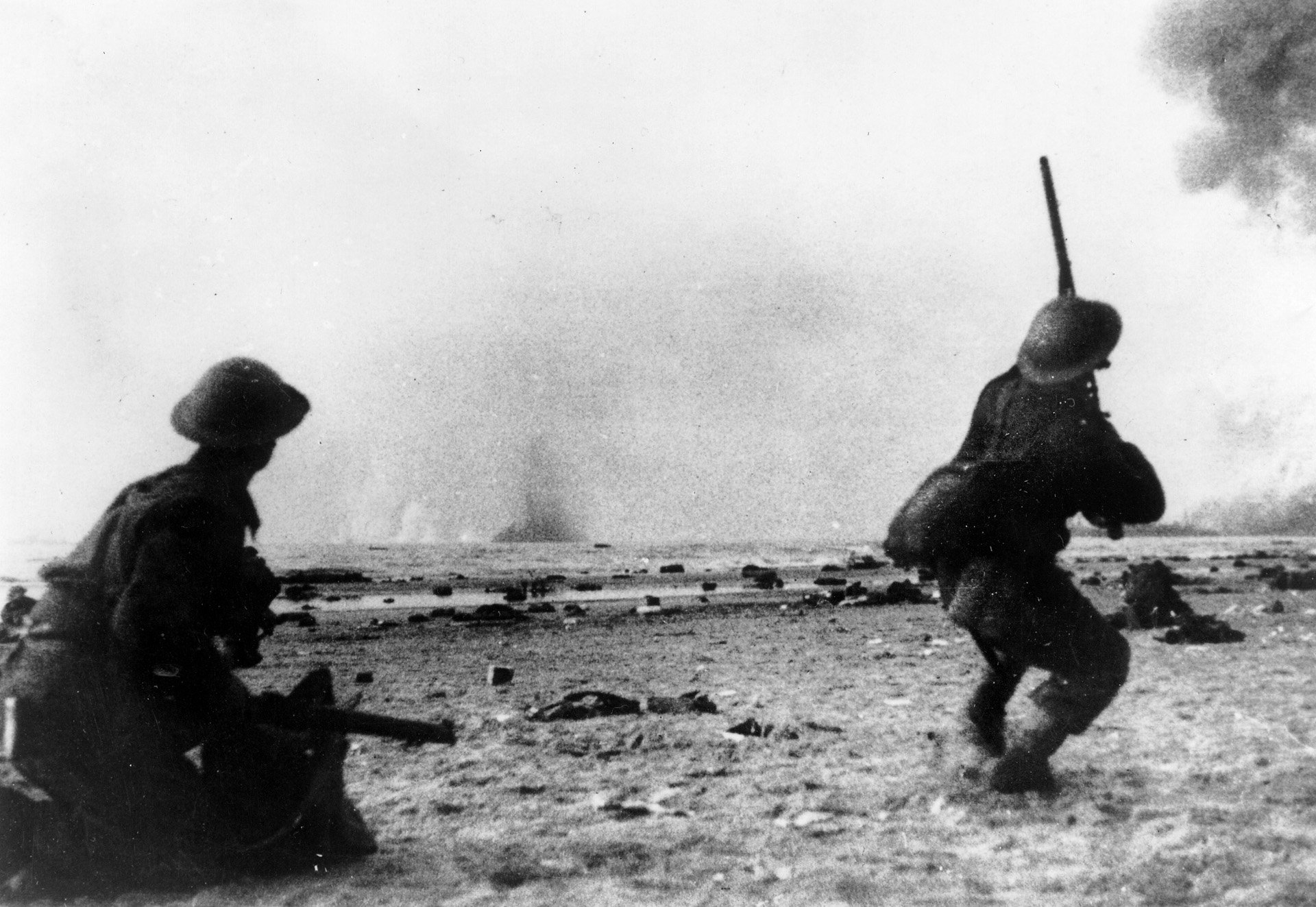
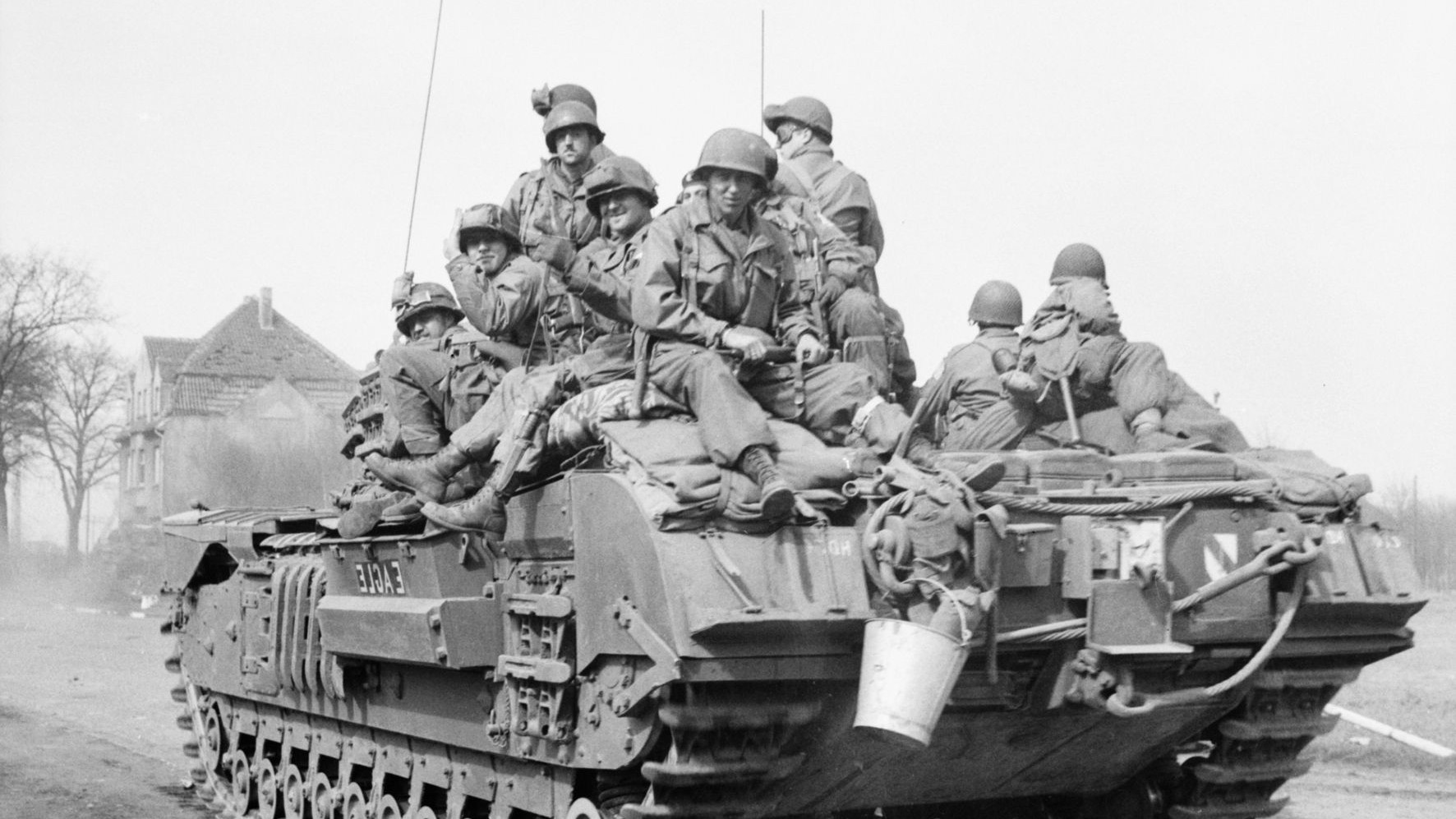
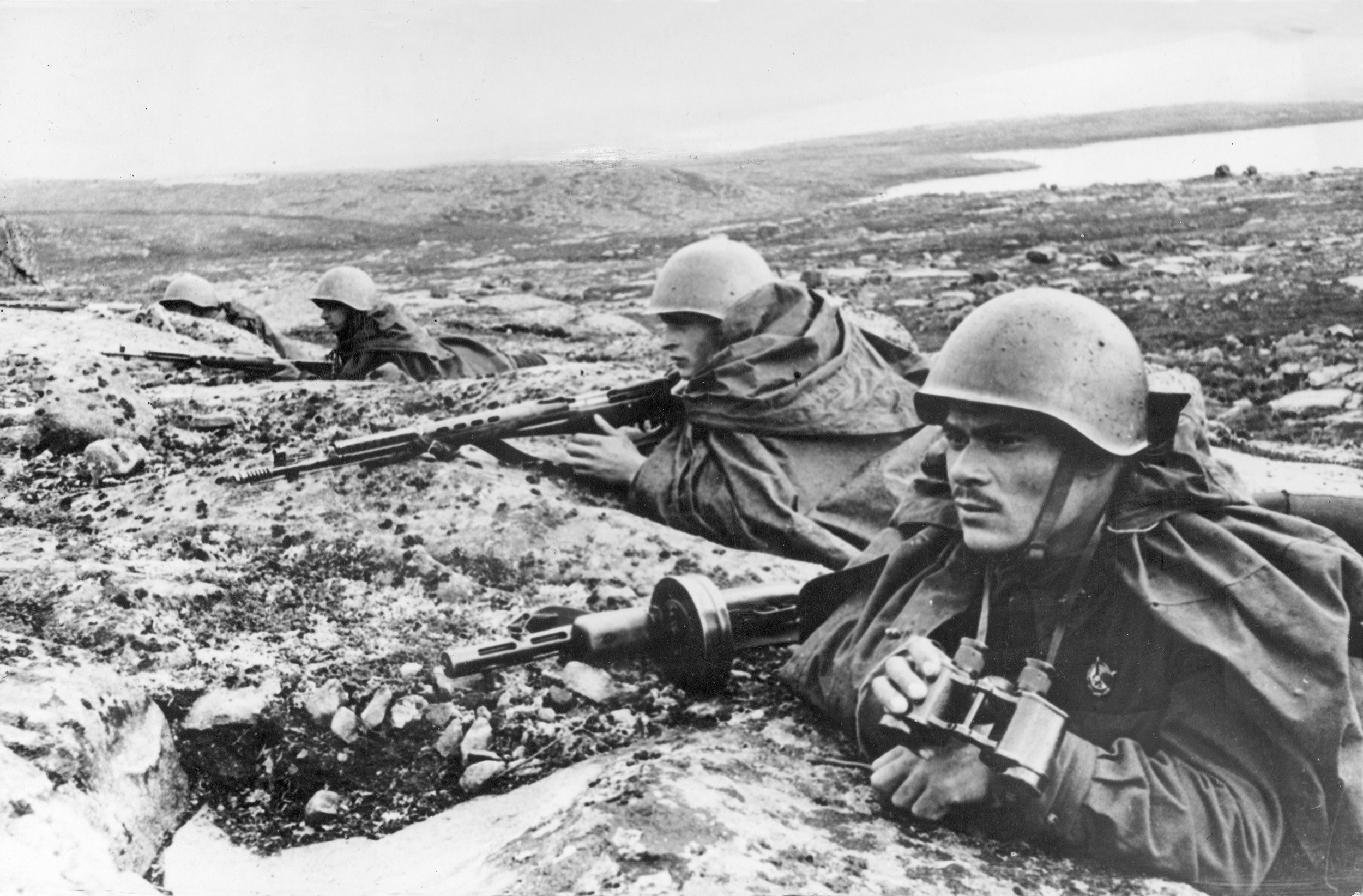
My father was in that battle RM Brownlie ex officier he was in charge of Vic God bless our service men